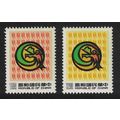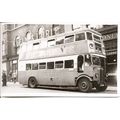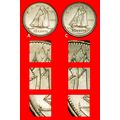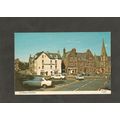Chagall, Marc - Peasant Life, 1925 - art postcard (Dutch)
- Condition : Used
- Dispatch : 2 Days
- Brand : None
- ID# : 200326611
- Quantity : 1 item
- Views : 248
- Location : United Kingdom

- Seller : justthebook (+1703)
- Barcode : None
- Start : Wed 14 Apr 2021 23:33:03 (BST)
- Close : Run Until Sold
- Remain : Run Until Sold
More Listings from This Seller view all
Seller's Description
- Art Postcard
- Work of art title: Peasant Life, 1925
- Artist (if known): Marc Chagall
- Media or other details: oil on canvas
- Publisher / Gallery: Art Unlimited, Amsterdam / Albright-Knox Art Gallery, Buffalo, New York
- Postally used: no
- Stamp & postmark details (if relevant):
- Size: Modern
- Notes & condition details:
NOTES:
Size: 'Modern' is usually around 6in x 4in or larger / 'Old Standard' is usually around 5½in x 3½in. Larger sizes mentioned, but if you need to know the exact size please ask as this can vary.
All postcards are not totally new and are pre-owned. It's inevitable that older cards may show signs of ageing and use, particularly if sent through the post. Any faults other than normal ageing are noted.
Stock No.: A1115
Please ask if you need any other information and I will do the best I can to answer.
------------------------------------------------
Postage and packing charge should be showing for your location (contact if not sure).
UK - PayPal, Cheque (from UK bank) or postal order
I will give a full refund if you are not fully satisfied with the postcard.
----------------------------------------------
Marc Chagall[a] (born Moishe Shagal; 6 July [O.S. 24 June] 1887 – 28 March 1985) was a Russian-French artist of Belarusian Jewish origin.[2][1] An early modernist, he was associated with several major artistic styles and created works in a wide range of artistic formats, including painting, drawings, book illustrations, stained glass, stage sets, ceramics, tapestries and fine art prints.
Art critic Robert Hughes referred to Chagall as "the quintessential Jewish artist of the twentieth century" (though Chagall saw his work as "not the dream of one people but of all humanity"). According to art historian Michael J. Lewis, Chagall was considered to be "the last survivor of the first generation of European modernists". For decades, he "had also been respected as the world's pre-eminent Jewish artist".[7] Using the medium of stained glass, he produced windows for the cathedrals of Reims and Metz, windows for the UN and the Art Institute of Chicago and the Jerusalem Windows in Israel. He also did large-scale paintings, including part of the ceiling of the Paris Opéra.
Before World War I, he travelled between Saint Petersburg, Paris, and Berlin. During this period he created his own mixture and style of modern art based on his idea of Eastern Europe and Jewish folk culture. He spent the wartime years in Soviet Belarus, becoming one of the country's most distinguished artists and a member of the modernist avant-garde, founding the Vitebsk Arts College before leaving again for Paris in 1923.
He had two basic reputations, writes Lewis: as a pioneer of modernism and as a major Jewish artist. He experienced modernism's "golden age" in Paris, where "he synthesized the art forms of Cubism, Symbolism, and Fauvism, and the influence of Fauvism gave rise to Surrealism". Yet throughout these phases of his style "he remained most emphatically a Jewish artist, whose work was one long dreamy reverie of life in his native village of Vitebsk."[8] "When Matisse dies," Pablo Picasso remarked in the 1950s, "Chagall will be the only painter left who understands what colour really is".[9]
Chagall biographer Jackie Wullschlager praises him as a "pioneer of modern art and one of its greatest figurative painters... [who] invented a visual language that recorded the thrill and terror of the twentieth century."[9] She adds:
On his canvases we read the triumph of modernism, the breakthrough in art to an expression of inner life that ... is one of the last century's signal legacies. At the same time Chagall was personally swept up in the horrors of European history between 1914 and 1945: world wars, revolution, ethnic persecution, the murder and exile of millions. In an age when many major artists fled reality for abstraction, he distilled his experiences of suffering and tragedy into images at once immediate, simple, and symbolic to which everyone could respond.[9]:4
Art historians Ingo Walther and Rainer Metzger refer to Chagall as a "poet, dreamer, and exotic apparition." They add that throughout his long life the "role of outsider and artistic eccentric" came naturally to him, as he seemed to be a kind of intermediary between worlds: "as a Jew with a lordly disdain for the ancient ban on image-making; as a Russian who went beyond the realm of familiar self-sufficiency; or the son of poor parents, growing up in a large and needy family." Yet he went on to establish himself in the sophisticated world of "elegant artistic salons."[67]:7
Through his imagination and strong memories Chagall was able to use typical motifs and subjects in most of his work: village scenes, peasant life, and intimate views of the small world of the Jewish village (shtetl). His tranquil figures and simple gestures helped produce a "monumental sense of dignity" by translating everyday Jewish rituals into a "timeless realm of iconic peacefulness".[67]:8 Leymarie writes that Chagall "transcended the limits of his century. He has unveiled possibilities unsuspected by an art that had lost touch with the Bible, and in doing so he has achieved a wholly new synthesis of Jewish culture long ignored by painting." He adds that although Chagall's art cannot be confined to religion, his "most moving and original contributions, what he called 'his message,' are those drawn from religious or, more precisely, Biblical sources."[28]:x
Walther and Metzger try to summarize Chagall's contribution to art:
His life and art together added up to this image of a lonesome visionary, a citizen of the world with much of the child still in him, a stranger lost in wonder—an image which the artist did everything to cultivate. Profoundly religious and with a deep love of the homeland, his work is arguably the most urgent appeal for tolerance and respect of all that is different that modern times could make.[67]:7
Andre Malraux praised him. He said: "[Chagall] is the greatest image-maker of this century. He has looked at our world with the light of freedom, and seen it with the colours of love."[68]
Listing Information
| Listing Type | Gallery Listing |
| Listing ID# | 200326611 |
| Start Time | Wed 14 Apr 2021 23:33:03 (BST) |
| Close Time | Run Until Sold |
| Starting Bid | Fixed Price (no bidding) |
| Item Condition | Used |
| Bids | 0 |
| Views | 248 |
| Dispatch Time | 2 Days |
| Quantity | 1 |
| Location | United Kingdom |
| Auto Extend | No |



 for 1 item(s)
for 1 item(s)















